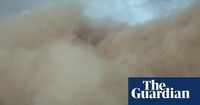On Monday, August 25, 2025, the city of Phoenix, Arizona, found itself at the mercy of nature’s raw power as a massive dust storm, known as a haboob, swept across the region. What began as an ordinary afternoon quickly turned extraordinary when a towering wall of dust, propelled by fierce winds, rolled in from the southeast, plunging the city and its suburbs into near-total darkness. Residents, drivers, and even seasoned meteorologists were left in awe—and, for some, fear—by the scale and intensity of the event.
According to AZ Central and USA TODAY, the haboob struck with little warning, prompting the National Weather Service in Phoenix to issue dust storm and severe thunderstorm warnings around 7:10 p.m. local time. Flash flood warnings followed soon after, as the storm’s impact became clear. The wall of dust, described as “apocalyptic” by witnesses and media alike, quickly enveloped neighborhoods, major highways, the Arizona State University football stadium, and the Phoenix Sky Harbor International Airport.
Bernae Boykin Hitesman, a resident of Arizona City—about 60 miles southeast of Phoenix—was caught in the storm while driving her two children home from school. She recounted the harrowing experience to the Associated Press: “I couldn’t see my hand in front of my face if I put my hand outside.” Forced to pull over, she described the sensation of tasting dust in the air and feeling the strong wind rattle her car. “I was nervous. My kids were really, really scared, so I was trying to be brave for them,” she said. The ordeal lasted about 15 minutes before the storm finally moved on.
The haboob’s reach was vast, stretching across Phoenix and neighboring communities. In Gilbert, retired university professor Richard Filley told The Guardian that the storm caused trees to sway and bird feeders to crash to the ground. Fine dust, he said, found its way into his house through “every little crack and space.” Reflecting on the experience, Filley remarked, “The windstorm part of it, I’m glad it’s gone. You look at the photos of haboobs and they are a spectacular natural phenomenon. They are kind of beautiful in their own way.”
But for many, beauty was the last thing on their minds. The storm’s ferocity knocked down trees, sent debris flying, and left sidewalks littered with downed branches. Street signs trembled in the wind, and the city’s iconic skyline was blotted out by the swirling dust. Videos and photos shared across social media captured the haboob’s approach—an immense, roiling wall of brown consuming everything in its path.
The impact on infrastructure was immediate and severe. More than 40,000 customers of Salt River Project, a major Arizona electric and water utility, lost power, while an additional 7,400 Arizona Public Service customers experienced outages, according to AZ Central. In Maricopa County, where Phoenix is located, tens of thousands were left in the dark. PowerOutage.us reported that at least 15,000 people in the county were affected at the height of the storm.
Phoenix Sky Harbor International Airport, one of the nation’s busiest, was not spared. The airport was forced to halt operations, grounding flights as visibility dropped to near zero and the storm battered the facility. According to the airport’s website and USA TODAY, 104 flights were delayed and three were cancelled. Wind gusts reached up to 70 mph, severely damaging a connector bridge and causing leaks in passenger areas. Heather Shelbrack, the airport’s deputy aviation director for public relations, told the Associated Press, “Crews have been identifying leaks and attempting to clean up water where it has collected in passenger areas.” The airport scrambled to assess and repair damage as soon as the worst had passed.
Haboobs are not entirely uncommon in the American Southwest, but the magnitude of this event was notable. The National Weather Service explained that haboobs form when strong thunderstorm winds, known as downdrafts, hit the ground and spread out rapidly, picking up loose dust and sand from arid areas and farm fields. These winds can reach speeds of 50 to 80 mph, carrying dust for up to 100 miles in some cases. “It’s all dependent on whether they’re moving through an area that’s prone to [generating] dust,” said Sean Benedict, a meteorologist at the National Weather Service’s Phoenix office. The corridor between Phoenix and Tucson is especially susceptible due to its dry, open landscape.
Once the dust had passed, the storm’s second act began: heavy rain, wind, and lightning swept through the region, compounding the chaos. Severe thunderstorms followed in the haboob’s wake, causing further wind damage and prolonging power outages. The National Weather Service’s warnings urged drivers to exercise extreme caution, advising them to “pull aside, stay alive.” For those caught on the roads, like Boykin Hitesman, the advice was both timely and necessary.
Interestingly, Phoenix’s haboob was not the only dust storm to make headlines that week. Over the preceding weekend, the Burning Man festival in Nevada’s Black Rock Desert was also battered by dust storms and high winds. Campers struggled to secure their tents and shelters as visibility dropped to near zero. Meteorologists warned that the harsh conditions could persist, with additional thunderstorms forecasted between Tuesday and Wednesday, and only drier weather expected by Thursday. AccuWeather even raised concerns about potential “minor flooding” in Nevada due to “monsoonal moisture.”
Scientists are paying close attention to such events, as they may signal broader changes driven by climate patterns. According to The Guardian, monsoons in the Southwest have become more intense since the 1970s, a trend linked to human-caused climate change. At the same time, droughts have grown longer and more severe, expanding arid regions and increasing the amount of loose dust available for storms to pick up. “The climate crisis increases the odds of both severe drought and heavier storms that could set the stage for more intense dust storms in the future,” Benedict explained. Land use, especially farming, also plays a role in determining how much dust is available for these dramatic weather events.
As Phoenix and its neighbors begin the long cleanup, the memory of August 25, 2025, will linger. For those who witnessed the haboob firsthand, it was a powerful reminder of nature’s ability to surprise—and overwhelm—even in a city accustomed to extreme weather.




